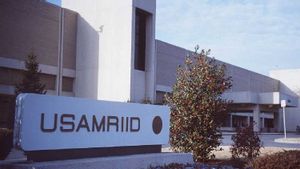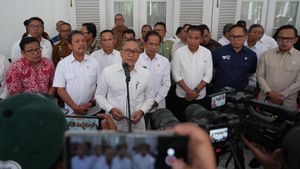JAKARTA - Tanjung Priok has long been a famous economic area. Not only attracting businessmen, but also a place to find food for thugs or thugs from various ethnic groups. There are conflicts in the history of Tanjung Priok. One of them happened between Lagoa from Bugis and Haji Tjitra from Banten.
During the Dutch colonial rule, Tanjung Priok Port was predicted to become an important economic area in Batavia (Jakarta). At that time, the Tanjung Priok port was prepared to replace the Sunda Kelapa port which was starting to experience silting. Dutch dizzy.
Steam ships could not dock there, so those who sailed from abroad had to lean far from the shore. As a result, loading and unloading of ships takes up a lot of time. Because, must use a small ship as an intermediary to the mainland.
Simultaneously, the number of large ships that docked began to increase. All of this was due to the shorter journey from the Netherlands/Europe to the Dutch East Indies thanks to the opening of the Suez Canal in 1869.
As a result, the construction of Tanjung Priok Port is prioritized. Under the leadership of the Governor General of the Dutch East Indies, Johan Wilhelm van Lansberge (1875-1881) Tanjung Priok Port was built in 1877.

"The Old Batavia Port (Sunda Kelapa) is no longer able to accommodate and serve merchant ships that are increasingly going in and out of the port. So a new port was built which is now known as Tanjung Priok or Tanjung Periuk. In the new port, new warehouses were also built to store goods to be shipped and transported abroad,” Sagimun Smooth Dumadi in his book Jakarta from the Edge of the Proclamation City (1988).
Even so, initially the construction of the Tanjung Priok Port was opposed by the Batavian businessmen. Most of the businessmen based in Kali Besar and Pasar Ikan consider the distance to the new port to be quite far. Therefore, many business people predict that the distance of almost nine kilos from Sunda Kelapa could be the cause of their business experiencing losses. However, the prediction was wrong.
The construction of the Tanjung Priok Port, which was completed in nine years or to be precise in 1886, became the main point of progress for Jakarta as the capital of the Dutch East Indies. In fact, the Netherlands is seriously preparing the facilities and infrastructure that can support activities to and from Tanjung Priok – from railway facilities to road construction. Along with this progress, the Port of Tanjung Priok was transformed into the main center of economic activity in Batavia.
“As the first safe seaport where ships can dock at the dock. However, when more and more investors came to Batavia, in 1912 the Priok Port was expanded because nearly 200 ships that year were waiting for their turn to dock," said Alwi Shahab in the book When the Dutch Drunk, Batavia was born (2013).
Lagoa, the Bugis rulers of PriokApart from being an economic barn, Tanjung Priok Port is also widely known as an onderwereld area (black world). All kinds of ethnic backgrounds use Priok as a money tree.
As a result, the priok area is closely related to the struggle for power of individuals and groups. During that period, one of the heroes who became the ruler of Priok Harbor from the 1930s-1550s was Lagoa.
The man whose full name is Labuang De Passore has even become famous throughout northern Jakarta. On the one hand, Lagoa is a community leader. On the other hand, Lagoa is also known as a master who doubles as a port foreman. His prowess in martial arts makes Lagoa have many followers, especially those of Bugis blood in Batavia.
“(Lagoa) A Bugis man who has a big name as the most respected person, became one of the rulers of the 'Onderwereld' in the North of Batavia/Jakarta in the 1930s and 1950s. His name came from the name of the residents among the masters and champions at Tanjung Priok Harbor, an economic area that is a place for 'sugar for ants' as well as rendezvous for people who have big guts," added culturalist and Betawi martial arts practitioner, GJ Nawi in the book Lagoa: Traces of the Jago Bugis in Tanah Betawi (2018).
The greatness of Lagoa, said GJ Nawi, is none other than the fact that he, who is a Bugis, holds tightly to the values of massompe (meantau). Which, for the Bugis, Massompe is interpreted as a process of maturation while seeking experience for the provision of life.
Thanks to that, a land full of violence like Tanjung Priok was conquered. Moreover, as a Bugis, he adheres to the term Siri' na pesse which means to be responsible and loyal friends.
The massompe tradition is not just an empty message. Bugis cultural observer Feby Triadi sees this tradition as a process of maturation. If we look at it from a cultural point of view, the meaning of massompe in the past is in line with the tradition of Bugis sailors who were required to have many skills, such as expanding the net of friendship, intimacy, and power.
The provision of expertise that makes Bugis people – including Lagoa – can grow up and exist in people's villages. Moreover, in the past, the people who perpetuated Massompe helped to equip him with other knowledge, such as deepening mammenca (pencak silat) and paddissenggeng (magic knowledge) such as Lagoa.
“This knowledge (mammenca) is only specifically for those who seek it and really want to equip themselves, usually this is done by people who really want to be champions. If almost all Bugis people know about paddissenggeng, people who learn mammenca too must know very well what paddissengeng is. But if paddissengeng is divided into many, some are indeed used for immunity, safety, mate, and sustenance," closed Feby Triadi.
Lagoa and Haji Tjitra's feud in PriokLagoa's journey to become the ruler of Tanjung Priok Port is not easy. Launching the Jakarta History page, often in each of his battles he is overwhelmed against his enemies.
In addition, there are also some of his enemies who actually become friends. Like meeting Sera, a martial arts expert from Bogor who later became his teacher.
After that, Lagoa's feud with other heroes continued. One of the most memorable feuds was his feud with a warrior from Banten Haji Tjitra bin Kidang.

Haji Tjitra is known as a champion who has been the ruler of Tanjung Priok Port from the 1920s. As the ruler of Tanjung Priok Port, because in general there is no single ruler from an ethnic background in the world of violence in the city of Jakarta, the two are always at odds.
The reason is because the arrival of Lagoa often disturbs Haji Tjitra's income barn. In every feud, victims from both sides fall. At its peak, news of their feud appeared in many newspapers in Batavia, to the point that no one predicted that the conflict would end. However, fate said otherwise. The two reconciled.
The peak of peace was marked by the appointment of Lagoa as the son-in-law of Haji Tjitra. The marriage also bridged the form of brotherhood and peace between the Bugis and Banten ethnic groups in Tanjung Priok. Maybe the two have reconciled. However, the echo of Tanjung Priok as a place for the masters to find food still persists, at least to this day.
*Read other information about HISTORY or read other interesting articles from Detha Arya Tifada.
Other MEMORIESThe English, Chinese, Japanese, Arabic, and French versions are automatically generated by the AI. So there may still be inaccuracies in translating, please always see Indonesian as our main language. (system supported by DigitalSiber.id)













